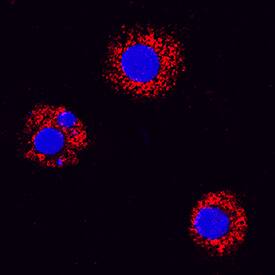Canine VEGF164 Biotinylated Antibody
R&D Systems, part of Bio-Techne | Catalog # BAF1603


Key Product Details
Species Reactivity
Validated:
Canine
Cited:
Canine
Applications
Validated:
ELISA Detection (Matched Antibody Pair), Immunocytochemistry, Western Blot
Cited:
ELISA Development
Label
Biotin
Antibody Source
Polyclonal Goat IgG
Product Specifications
Immunogen
E. coli-derived recombinant canine VEGF164
Pro28-Arg190
Accession # Q9MYV3.3
Pro28-Arg190
Accession # Q9MYV3.3
Specificity
Detects canine VEGF164 in ELISAs and Western blots. In sandwich immunoassays, 100% cross-reactivity with recombinant human VEGF is observed and less than 2% cross-reactivity with recombinant rat VEGF and recombinant mouse VEGF is observed.
Clonality
Polyclonal
Host
Goat
Isotype
IgG
Scientific Data Images for Canine VEGF164 Biotinylated Antibody
VEGF in Canine PBMCs.
VEGF was detected in immersion fixed canine peripheral blood mononuclear cells (PBMCs) using Goat Anti-Canine VEGF 164 Biotinylated Antigen Affinity-purified Polyclonal Antibody (Catalog # BAF1603) at 15 µg/mL for 3 hours at room temperature. Cells were stained using the NorthernLights™ 557-conjugated Streptavidin (red; Catalog # NL999) and counterstained with DAPI (blue). Specific staining was localized to cytoplasm. View our protocol for Fluorescent ICC Staining of Non-adherent Cells.Applications for Canine VEGF164 Biotinylated Antibody
Application
Recommended Usage
Immunocytochemistry
5-15 µg/mL
Sample: Immersion fixed canine peripheral blood mononuclear cells
Sample: Immersion fixed canine peripheral blood mononuclear cells
Western Blot
0.1 µg/mL
Sample: Recombinant Canine VEGF (Catalog # 1603-CV)
Sample: Recombinant Canine VEGF (Catalog # 1603-CV)
Canine VEGF Sandwich Immunoassay
Please Note: Optimal dilutions of this antibody should be experimentally determined.
Formulation, Preparation, and Storage
Purification
Antigen Affinity-purified
Reconstitution
Reconstitute at 0.2 mg/mL in sterile PBS.
Formulation
Lyophilized from a 0.2 μm filtered solution in PBS with BSA as a carrier protein.
Shipping
The product is shipped at ambient temperature. Upon receipt, store it immediately at the temperature recommended below.
Stability & Storage
Use a manual defrost freezer and avoid repeated freeze-thaw cycles.
- 12 months from date of receipt, -20 to -70 °C as supplied.
- 1 month, 2 to 8 °C under sterile conditions after reconstitution.
- 6 months, -20 to -70 °C under sterile conditions after reconstitution.
Background: VEGF
Long Name
Vascular Endothelial Growth Factor
Alternate Names
MVCD1, VAS, Vasculotropin, VEGF-A, VEGFA, VPF
Entrez Gene IDs
Gene Symbol
VEGFA
UniProt
Additional VEGF Products
Product Documents for Canine VEGF164 Biotinylated Antibody
Product Specific Notices for Canine VEGF164 Biotinylated Antibody
For research use only
